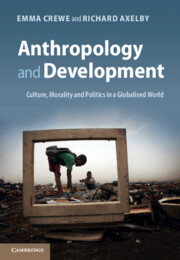Book contents
- Frontmatter
- Contents
- List of acronyms
- Preface and acknowledgements
- 1 Introduction
- 2 Anthropologists engaged
- 3 The social and political organisation of aid and development
- 4 The elusive poor
- 5 Human rights and cultural fantasies
- 6 Hierarchies of knowledge
- 7 The moralities of production and exchange
- 8 The politics of policy and practice
- 9 Imagining the future
- Appendix: challenging questions arising from this book
- Notes
- References
- Index
9 - Imagining the future
Published online by Cambridge University Press: 05 November 2012
- Frontmatter
- Contents
- List of acronyms
- Preface and acknowledgements
- 1 Introduction
- 2 Anthropologists engaged
- 3 The social and political organisation of aid and development
- 4 The elusive poor
- 5 Human rights and cultural fantasies
- 6 Hierarchies of knowledge
- 7 The moralities of production and exchange
- 8 The politics of policy and practice
- 9 Imagining the future
- Appendix: challenging questions arising from this book
- Notes
- References
- Index
Summary
This book is a collection of anthropological perspectives on development. Having introduced the multiple agencies and actors that inhabit Development World, we described some of the most significant and influential aspects of their thinking. The world of development is full of layers, tensions and even contradictions. ‘Development’ is, at different times, used as a synonym for ‘poverty reduction’, ‘rights’, ‘science and technology’, ‘growth’ and ‘freedom’. Planned development takes place within a context of development in a broader sense – change brought about capitalistic expansion and globalisation. We need to explain why development can be so many things to so many people and how thinking is shaped by institutional practices. In this final chapter we will look at how the promoters of development create and make sense of the future and finally what anthropologists can contribute to our understanding of development.
The spaces between
Someone once described music as the space between notes. Astronomers often see the universe in the pull of total control on the one side and total chaos on the other; economists look to the space between supply and demand to determine value and price. Should we not do the same?
(Severs 2001: 103)Space is assumed to be unimportant and empty. But it can contain much of significance that is ignored; it is often the unexplained and unexplored between two points in time or place, between concepts or between layers of experience, within which social life is experienced. At the same time, the points or poles are not only culturally constructed, along with the space within and between them, but contested and continually so. This book has shown how anthropologists can uncover the relevance of ‘the spaces between’. A fuller understanding of Development World is revealed when attention turns to the overlooked and unconsidered within and between gaps, layers and contradictions.
Information
- Type
- Chapter
- Information
- Anthropology and DevelopmentCulture, Morality and Politics in a Globalised World, pp. 213 - 228Publisher: Cambridge University PressPrint publication year: 2012
